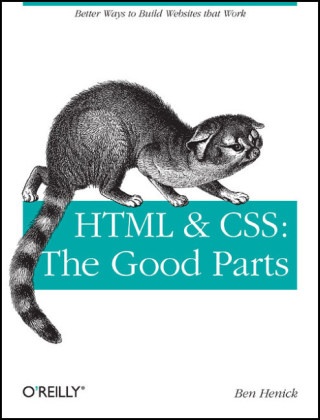Condividi
Fr. 48.90
Ben Henick, Henick Ben
HTML and CSS - The Good Parts
Inglese · Tascabile
Spedizione di solito entro 3 a 5 settimane
Descrizione
Informationen zum Autor Ben Henick has been building Web sites since September 1995, when he took on his first Web project as an academic volunteer. He has worked in nearly every aspect of site design and development, from foundation HTML through finicky CSS to larger scale architecture and content management. He has written for A List Apart, the Web Standards Project, and most recently for Opera Software's Web Standards Curriculum. Klappentext HTML and CSS are the workhorses of web design! and using them together to build consistent! reliable web pages requires both skill and knowledge. The task is more difficult if you're relying on outdated! confusing! and unnecessary HTML hacks and workarounds. Author Ben Henick shows you how to avoid those traps by going beyond the standard tips! tricks! and techniques to connect the underlying theory and design of HTML and CSS to your everyday work habits. With this practical book! you'll learn how to work with these tools far more effectively than is standard practice for most web developers. Whether you handcraft individual pages or build templates! HTML & CSS: The Good Parts will help you get the most out of these tools in all aspects of web page design-from layout to typography and to color. * Structure HTML markup to maximize the power of CSS * Implement complex multi-column layouts from scratch * Improve site production values with advanced CSS techniques * Support formal usability and accessibility requirements with tools built into HTML and CSS * Avoid the most annoying browser and platform limitations Zusammenfassung Covers different aspects of web page design, from typography and color to layout. This book helps you learn which pieces of HTML and CSS deserve focus, and which can be abandoned. It also lets you discover how the two technologies tightly mesh. Inhaltsverzeichnis Preface; The Who and What of This Book; Objectives of This Book; Conventions Used in This Book; Using Code Examples; Safari® Books Online; How to Contact O'Reilly; Acknowledgments;Chapter 1: Hypertext at the Core; 1.1 The Web Without Links; 1.2 URIs;Chapter 2: Working with HTML Markup; 2.1 HTML Syntax; 2.2 Rendering Modes, Flavors of HTML, and Document Type Declarations; 2.3 Beautiful Parts: Universal Attributes; 2.4 Separating Content, Structure, Presentation, and Behavior; 2.5 Browsers, Parsing, and Rendering;Chapter 3: CSS Overview; 3.1 Connecting Stylesheets to HTML Documents; 3.2 Choosing the Elements You Want to Style: Writing Selectors; 3.3 Rule Conflicts, Priority, and Precedence; 3.4 CSS Property and Value Survey; 3.5 CSS Units; 3.6 Key CSS Layout Properties;Chapter 4: Developing a Healthy Relationship with Standards; 4.1 The Broad Landscape of Web-Related Standards; 4.2 Why Web Standards?; 4.3 Taking the Middle Road: Standards-Friendliness;Chapter 5: Effective Style and Structure; 5.1 The Four Habits of Effective Stylists; 5.2 CSS Zen and the Stylist's Experience; 5.3 Information Architecture and Web Usability;Chapter 6: Solving the Puzzle of CSS Layout; 6.1 The CSS Box Model and Element Size Control; 6.2 Quirks Mode and Strict Mode; 6.3 auto Values; 6.4 Margins, Borders, and Padding; 6.5 Element Flow; 6.6 Using the display Property to Change an Element's Flow; 6.7 The float and clear Properties; 6.8 Implementing Multicolumn Layouts; 6.9 CSS Positioning Properties; 6.10 The visibility and z-index Properties; 6.11 Obtaining Precise Navigation Source Order and Layout; 6.12 Layout Types and Canvas Grids;Chapter 7: Working with Lists; 7.1 Ordered and Unordered Lists; 7.2 Other Uses for Lists; 7.3 Styling Navigation Elements; 7.4 Definition Lists;Chapter 8: Headings, Hyperlinks, Inline Elements, and Quotations; 8.1 Headings and Good Writing; 8.2 Styling Heading Elements; 8.3 Link Markup; 8.4 Styling Links; 8.5 Adding Seman...
Sommario
Inhaltsverzeichnis
Chapter 1 Pattern Recognition
Understanding Search
The Discovery of Color
Elephant in the Room
A Mapmaker's Manifesto
Apophenia Redux
Chapter 2 The Anatomy of Search
Users
Interface
Engine
Content
Creators
Context
Chapter 3 Behavior
Patterns of Behavior
Elements of Interaction
Principles of Design
Chapter 4 Design Patterns Autocomplete
Best First
Federated Search
Faceted Navigation
Advanced Search
Personalization
Pagination
Structured Results
Actionable Results
Unified Discovery
The End of the Beginning
Chapter 5 Engines of Discovery
Category
Topic
Format
Audience
Platform
Mode
Chapter 6 Tangible Futures
Methods and Deliverables
Search Scenarios
Experience Discovery
Appendix Recommended Reading
Colophon
Dettagli sul prodotto
| Autori | Ben Henick, Henick Ben |
| Editore | Wiley, John and Sons Ltd |
| Lingue | Inglese |
| Formato | Tascabile |
| Pubblicazione | 05.03.2010 |
| EAN | 9780596157609 |
| ISBN | 978-0-596-15760-9 |
| Serie |
Animal Guide Animal Guide |
| Categorie |
Scienze naturali, medicina, informatica, tecnica
> Informatica, EDP
> Linguaggi di programmazione
block, justification, web development, Safari, model, COMPUTERS / Internet / Web Programming |
Recensioni dei clienti
Per questo articolo non c'è ancora nessuna recensione. Scrivi la prima recensione e aiuta gli altri utenti a scegliere.
Scrivi una recensione
Top o flop? Scrivi la tua recensione.

